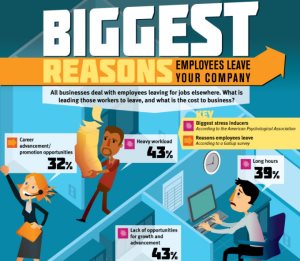Infographic Details Biggest Reasons Employees Resign

According to the infographic Biggest Reasons Why Employees Leave Your Company by Bolt Insurance, 32 percent of workers polled in a Gallup survey said career advancement/promotion opportunities were the main reasons they leave a company. Pay/benefits was the second biggest reason for leaving (22 percent) while lack of a fit to the job came in 3rd place with 20 percent. The smallest reasons for employee resignations were scheduling conflicts and job security at 8 percent and 2 percent, respectively.
The infographic detailed the biggest stress inducers, according to the American Psychological Association. Almost half (43 percent) of respondents said a heavy workload and lack of growth and advancement opportunities are the biggest stress inducers. Unrealistic job expectations also cause a significant amount of stress at 40 percent and 39 percent of those polled reported long hours as a major stress inducer.
Employee recognition was also highlighted on the infographic with just below half (43 percent) of participants saying they receive adequate non-monetary rewards and recognition for their contributions at work. One in two employees don’t feel valued on their job and 3 in 10 plan to seek employment elsewhere.
So, just how much does turnover affect companies? The infographic also covers that:
- $5,500 is the average turnover cost for an employee earning $8/hour
- Turnovers cost companies around 30-50 percent of an entry-level worker’s salary, 140 percent of a mid-level worker’s salary and up to 400 percent of a senior-level position’s salary
- Employee turnover has direct and indirect costs. Direct costs can be recruitment, training a new employee and temporary replacement workers. Indirect costs range from lost productivity to the time a manager will have to take to interview candidates.


